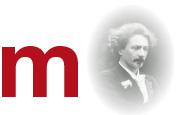The Riond-Bosson estate
Ignacy Paderewski was a welcome guest everywhere, but he also knew how to entertain: in the late nineteenth century he acquired a most peculiar property at Riond-Bosson near Morges, in the Commune of Tolochenaz, formerly residence of the Duchess of Otrante, widow of Joseph Fouché, where he would catch his breath between concert tours. The charming and resourceful Helena Paderewska, half-princess and half-country girl, reigned over the property. Today the mansion is no more – the army dynamited it in 1965, further heightening its mystery. Part chalet and part Venetian palace, the vast estate abounded in flora and fauna, where splendour blended with rusticity and added to the Paderewski legend.
The Duchess of Otrante Palace
Acquired in 1899, Riond-Bosson was formerly the property of the Duchess of Otrante, born Ernestine de Castellane, widow of Joseph Fouché. The Paderewskis had been told of its availability by their friend the Princess of Brancovan, residing in Amphion on the other side of the lake. Their decision to buy the estate was greatly influenced by the proximity of many of their acquaintances in the region – René Morax, Gustave Doret, Ernest Schelling, Alfred Pochon and Anton Suter to name a few –, by the breathtaking surrounding beauty of lake and mountain sceneries, by the sheer peacefulness of the area, perfect for him to complete the work of his life (his Manru Opera), and lastly by the climate, ideal for the fragile health of their son Alfred.
In the recollection of Arthur Rubinstein
« I was struck first by the two concert grands with their keyboards facing each other, lined up along two bay windows. [...] Both pianos were covered with flowers and framed photographs of kings and queens, Spanish infantas, and prominent aristocrats. I noticed also one or two prominent Americans, but, to my astonishment, no Poles. » Excerpt from « My Young Years » the first tome of the three-volume autobiography by pianist Arthur Rubinstein (New York, Alfred A. Knopf, 1973)
The empire of Helena Paderewska
« There she stood, in the doorway, surrounded by hydrangeas a shade brighter than her summer dress », recalled René Morax in the Journal de Lausanne on 23rd January 1934. « Her features like those of a Greek muse appear unfazed beneath her luscious black hair. She awaits, as would a queen, tribute from the Riond-Bosson guests. Seated at the table whilst the Master’s dazzling wit enlightens the conversation, she oversees the service with both tact and authority, in a flawless lady-of-the-house fashion. »
The poultry farming enterprise
The impressive « Mrs Paderewska’s Poultry Farm » (as captioned on postcards) counted up to 2,500 purebred chickens, as well as many rare birds (golden pheasants, parrots, peacocks...), award winners at poultry farming exhibitions.
« What a joy for me to see my hens and grapes again »
This activity certainly is not a lady’s passing fancy, as testified by these words printed in Le Petit Parisien on 8th June 1923 just before another departure for the United States: « What a joy for me to see my hens and grapes again, by the lakeshore. I had left them with great sadness. But I could not – could I? – have preferred them over my great... »
« The grass where graze the sheep given by the King of England... »
« She gazes at the blue mountains beyond the trees of the park », wrote René Morax in the Journal de Lausanne on 23rd January 1934. « She embellished and transformed the park herself, and her thoughts wander yonder with the lands she converted into perfect coops, plant nurseries and gardens. Her realm stretches out beyond the pine woods that line the grass where graze the sheep given by the King of England; she feels perfectly at home here and she is particularly fond of showing her domain to visitors. »


